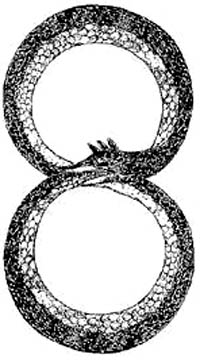"[The Christian's] fundamental belief in the efficacy of baptism led him to find this mystical symbol everywhere and imbue it with Christian meaning. The Lord rose on the eighth day: on an Easter Sunday, the liturgical eighth day, the Christian received baptism; and this is the day on which the 'Spirit moved upon the face of the waters.' Eight persons rode the ark over the waters, and this wooden structure by which man was saved is a symbol of the Cross."
--Hugo Rahner, Greek Myths and Christian Mysteries
"For Christ, the first born of all creation, is become the beginning of a new race, the race of those who by virtue of the mystery of the cross are born again of him by water and faith and the wood."
--Justin Martyr, Dialogus cum Tryphone, 2nd century
Early Christians tended to build their baptisteries in octagonal form, with an eight-cornered rail.
"The holy temple has eight niches,
octagonal is the font, worthy of its sacred work.
The house of our baptism must be built in the mystical eight."
-- from a Latin inscription by St. Ambrose on the baptistery of St. Thecla at Milan, 4th century

"... the ogdoad is understood frequently as the dual four, which is identical with the below and above, the boundless infinite, from whom emanated the Logos, or Word."
--Marie L Farrington, Facing the Sphinx, 1889
"The Ogdoad was a company of eight creator-gods a Hermopolis (ancient name Khmnu, 'City of the Eight'), one of the oldest religious centers in Egypt. The eight gods comprised four male-and-female couples, who each personified aspects of primeal chaos: Nun and Nunet (the waters), Heh and Hehet (the flood), Kek and Keket (the darkness), and Amun and Amaunet (invisible wind). [...] The Ogdoad are thus called 'the fathers and mothers who made the light', 'the men and women who created the light', or 'the waters that made the light'."
--Alan F. Alford, The Midnight Sun: The Death and Rebirth of God in Ancient Egypt

--Hugo Rahner, Greek Myths and Christian Mysteries
"For Christ, the first born of all creation, is become the beginning of a new race, the race of those who by virtue of the mystery of the cross are born again of him by water and faith and the wood."
--Justin Martyr, Dialogus cum Tryphone, 2nd century
Early Christians tended to build their baptisteries in octagonal form, with an eight-cornered rail.
"The holy temple has eight niches,
octagonal is the font, worthy of its sacred work.
The house of our baptism must be built in the mystical eight."
-- from a Latin inscription by St. Ambrose on the baptistery of St. Thecla at Milan, 4th century

"... the ogdoad is understood frequently as the dual four, which is identical with the below and above, the boundless infinite, from whom emanated the Logos, or Word."
--Marie L Farrington, Facing the Sphinx, 1889
"The Ogdoad was a company of eight creator-gods a Hermopolis (ancient name Khmnu, 'City of the Eight'), one of the oldest religious centers in Egypt. The eight gods comprised four male-and-female couples, who each personified aspects of primeal chaos: Nun and Nunet (the waters), Heh and Hehet (the flood), Kek and Keket (the darkness), and Amun and Amaunet (invisible wind). [...] The Ogdoad are thus called 'the fathers and mothers who made the light', 'the men and women who created the light', or 'the waters that made the light'."
--Alan F. Alford, The Midnight Sun: The Death and Rebirth of God in Ancient Egypt




No comments:
Post a Comment